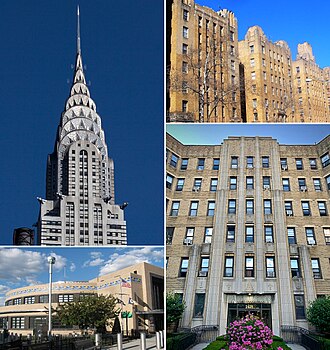
Art Deco architecture flourished in New York City during the 1920s and 1930s. The style broke with many traditional architectural conventions and was characterized by verticality, ornamentation, and building materials such as plastics, metals, and terra cotta. Art Deco is found in government edifices, commercial projects, and residential buildings in all five boroughs. The architecture of the period was influenced by worldwide decorative arts trends, the rise of mechanization, and New York City's 1916 Zoning Resolution, which favored the setback feature in many buildings.
The exuberant economy of the Roaring Twenties and commercial speculation spurred a citywide building boom. The size and sophistication of Art Deco ranged from towering skyscrapers to modest middle-class housing and municipal buildings. Colorful, lavishly-decorated skyscrapers came to dominate the skyline of Manhattan before the Great Depression ended their construction. The Depression and changing tastes pushed the style to more subdued applications as it spread in the 1930s, becoming a style of choice for infrastructure projects and modern middle-class apartments in the outer boroughs.
A lull in construction during World War II and the rise of the International Style led to the end of new Art Deco in the city. After falling out of favor and suffering from neglect during the city's downturn in the latter half of the 20th century, the city's Art Deco has been reappraised. Among New York's most treasured and recognizable skyscrapers are the Art Deco Empire State and Chrysler buildings. Art Deco skyscrapers formed the core of the city's skyline for decades and influence modern construction. Many of these buildings are protected by historic preservation laws, while others have been lost to new development or neglect.
© MMXXIII Rich X Search. We shall prevail. All rights reserved. Rich X Search
